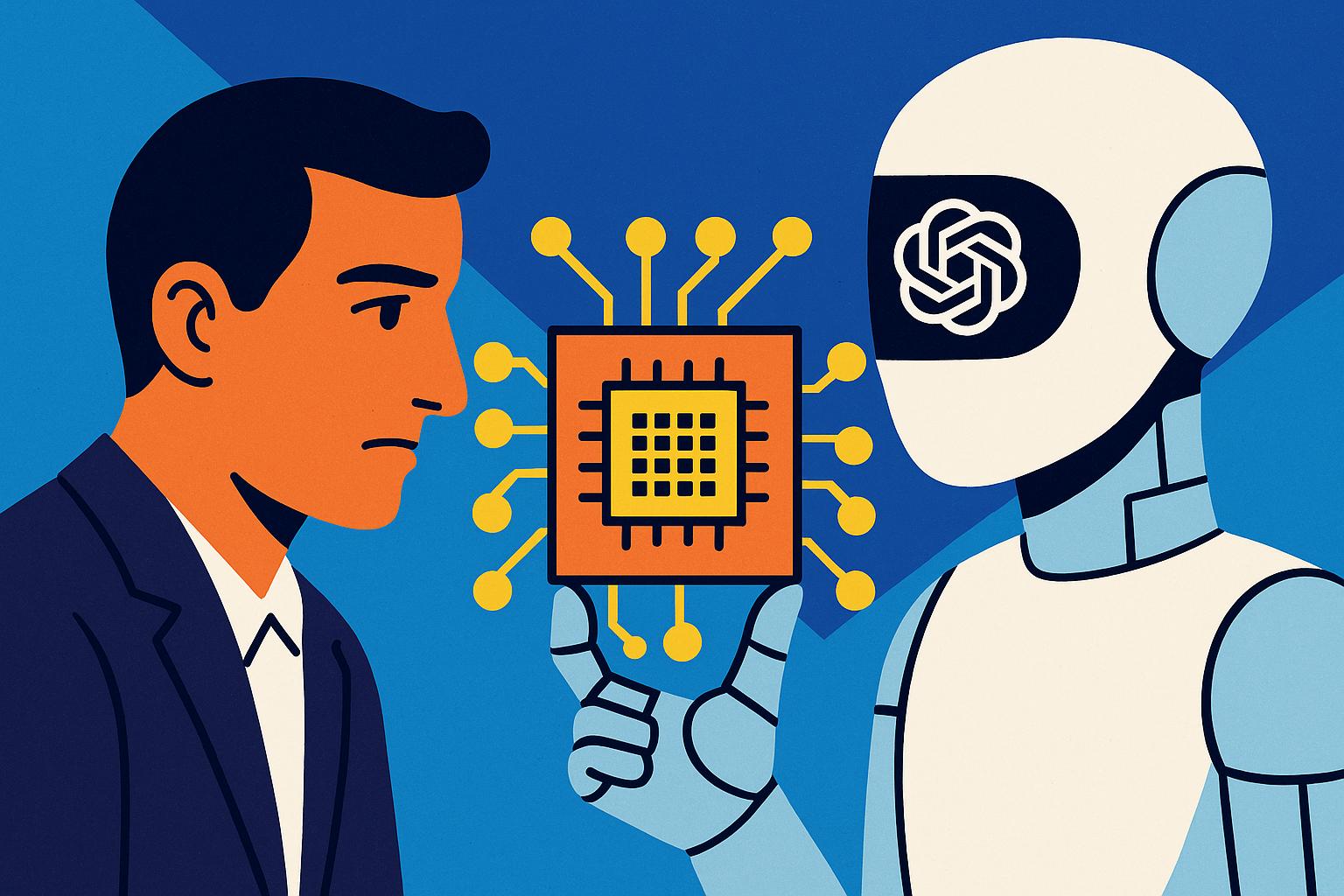Visit Our websites

OpenAI’s Bold Move Into AI Chips
OpenAI’s bold move into AI chips is reshaping how the artificial intelligence industry confronts infrastructure dependency, cost constraints, and long-term ambitions for artificial general intelligence (AGI). With rising costs, global supply constraints, and reliance on Nvidia reaching critical levels, OpenAI, led by CEO Sam Altman, is reportedly pursuing custom chip development and dedicated compute sites. This decision mirrors similar strategies by Google, Amazon, and Microsoft. However, it carries distinct implications due to OpenAI’s unique governance, AGI roadmap, and investor ecosystem. As the generative AI boom fuels an insatiable demand for computing resources, OpenAI’s shift toward hardware control signals a strategic recalibration that could redefine leadership in the AI infrastructure race.
Key Takeaways
- OpenAI is pursuing in-house AI chip development to reduce dependence on Nvidia’s GPUs amid global shortages and rising costs.
- The move reflects an industry-wide trend of vertical integration, already followed by companies such as Google, Amazon, and Microsoft.
- This pivot could impact global AI infrastructure, influence AGI timelines, and reshape power dynamics across big tech ecosystems.
- OpenAI’s unique governance model and mission-oriented focus differentiate its chip strategy from commercial counterparts.
Also Read: Amazon Accelerates Development of AI Chips
Why OpenAI Is Focusing on AI Chips Now
The decision to explore proprietary OpenAI AI chips has been driven by a combination of external pressures and long-term vision. The ongoing Nvidia GPU shortage 2024, triggered by surging demand from AI companies, has created severe bottlenecks in model training and inference capacities. GPUs such as Nvidia’s A100 and H100 are critical components for AI workloads, and their scarcity has inflated costs and limited scalability.
Reports suggest that top-tier GPUs now cost tens of thousands of dollars per unit. This has made hardware acquisition a primary expense in AI model development. For OpenAI, which is commercializing models like GPT-4 and building pathways toward AGI, sustained access to compute is non-negotiable. CEO Sam Altman has openly discussed the urgent need for greater infrastructure autonomy and hinted at creating a robust “Plan B.”
This “Plan B” reportedly includes developing custom silicon and investing in large-scale compute infrastructure. By designing chips tailored specifically for its workloads, OpenAI could reduce latency, minimize power consumption, and align hardware capabilities more closely with future software architectures.
Also Read: Nvidia’s Bold Investment in Robotics and AI
How Big Tech Competitors Have Approached AI Chip Strategy
The concept of vertical integration in AI hardware is not new. Major cloud and AI companies have spent the last decade building customized chips to avoid dependency on external GPU vendors. The chart below summarizes key moves:
| Company | Chip Name | Year Launched | Primary Use Case | Manufacturing Partner |
|---|---|---|---|---|
| TPU (Tensor Processing Unit) | 2016 | Model training and inference for Google Services | TSMC | |
| Amazon (AWS) | Trainium & Inferentia | 2020 (Trainium) | Cloud inference and training (AWS customers) | Various (Incl. TSMC) |
| Microsoft | Azure Maia AI Accelerators | 2023 | Azure OpenAI Service | Reportedly TSMC |
This trend toward vertical integration enables companies to optimize performance across hardware and software layers. It also positions them to control costs and scale global AI deployments more efficiently.
What Makes OpenAI’s Chip Vision Unique?
While several tech giants have integrated AI chip engineering into their cloud strategies, OpenAI’s approach is distinct in several ways. The most notable differentiator is its mission to develop AGI that benefits all of humanity, governed by its non-profit charter. Unlike cloud-first competitors, OpenAI’s AI infrastructure investment is intrinsically linked to ethical deployment, safety research, and democratized access.
Sam Altman’s AI chip strategy reportedly includes raising billions with backing from global investors. OpenAI is not just eyeing chip design. It is also considering manufacturing partnerships or acquisitions of chip design firms. According to Reuters, these efforts are aimed at creating a vertically integrated hardware-software stack purpose-built for next-generation AI models.
This move could enable OpenAI to architect chips around anticipated breakthroughs in model comprehension, reasoning, and safety rather than retrofitting general-purpose hardware. OpenAI’s roadmap also emphasizes long-term sustainability, including powering data centers with renewable energy and optimizing compute per inference token.
Also Read: Indian Startup Develops AI System Without Advanced Chips
The Strategic Pressure of Nvidia’s Dominance
Nvidia remains the undisputed leader in AI acceleration, with over 80 percent GPU market share for data centers. The company’s CUDA software ecosystem has become the default for training deep learning models. However, this dominance comes with strategic risks for AI developers. In 2024 alone, Nvidia GPUs have reported wait times of several months. This has affected both startups and major platforms.
Reports suggest that the price for high-end GPUs like the H100 can exceed 30,000 dollars per unit. Building or leasing clusters of thousands of these processors significantly increases infrastructure capital expenditure. For an organization scaling foundation models at global levels, such costs can quickly become unsustainable without operational control.
By designing its own AI infrastructure chips, OpenAI could diversify its supply chain and mitigate risk due to geopolitical tensions, component shortages, or price inflation. This mirrors why Apple transitioned to its own M-series chips: optimization, performance, and sovereignty.
Broader Implications for AI Infrastructure and Global Competition
The OpenAI move also signals shifting power lines in the global AI sector. AI infrastructure investment is becoming a strategic pillar not only for businesses but also for national economies. Chip autonomy, compute access, and cross-border collaborations will increasingly define which markets dominate AI innovation.
Relying heavily on Nvidia, a US-headquartered company, raises questions for regions aiming to secure sovereign AI development pipelines. Emerging markets could face increasing difficulty accessing elite GPU compute due to allocation constraints. If OpenAI successfully transitions into hardware, it could impact how generative AI is deployed globally, especially in non-Western ecosystems with limited infrastructure.
In this light, OpenAI’s hardware pivot reflects not just a business strategy. It also represents an alignment of engineering resources with social ambitions. Control over chips influences research directions, pricing models, and who gets to participate in the AI future.
Also Read: Nvidia Dominates AI Chips; Amazon, AMD Rise
Expert Perspective: Why Hardware Control Matters
VC Insight: “In the world of AI, whoever controls the compute controls the pace of innovation. OpenAI’s vertical move into silicon is not just about scaling. It is about independence, customization, and competitive edge. We expect more companies to follow this path to remain viable in the long term.” — Managing Partner, Silicon Valley-based AI Venture Firm.
Looking Ahead: What Comes Next for OpenAI’s Chip Strategy?
While timelines remain unclear, industry insiders suggest OpenAI might announce official chip-related initiatives within the next 12 to 24 months. A capped profit structure and mission-first culture could allow it to approach chip architecture differently than its peers. OpenAI may focus more on training efficiency, safety monitoring, and fairness scaling than on serving diversified cloud clients.
In parallel, its strategic partnership with Microsoft may help expedite access to design and foundry partners. This may be enabled by Microsoft’s own growing silicon ambitions. As the competition to control AI infrastructure accelerates, OpenAI’s chip plan could dictate how equitably and ethically the next phase of AI unfolds.
Its success or failure will have ripple effects across software innovation, academic research access, and the economics of AGI development.
References
Brynjolfsson, Erik, and Andrew McAfee. The Second Machine Age: Work, Progress, and Prosperity in a Time of Brilliant Technologies. W. W. Norton & Company, 2016.
Marcus, Gary, and Ernest Davis. Rebooting AI: Building artificial intelligence We Can Trust. Vintage, 2019.
Russell, Stuart. Human Compatible: artificial intelligence and the Problem of Control. Viking, 2019.
Webb, Amy. The Big Nine: How the Tech Titans and Their Thinking Machines Could Warp Humanity. PublicAffairs, 2019.
Crevier, Daniel. AI: The Tumultuous History of the Search for artificial intelligence. Basic Books, 1993.
BONUS LINK VISIT NOW
Visit Our websites



















